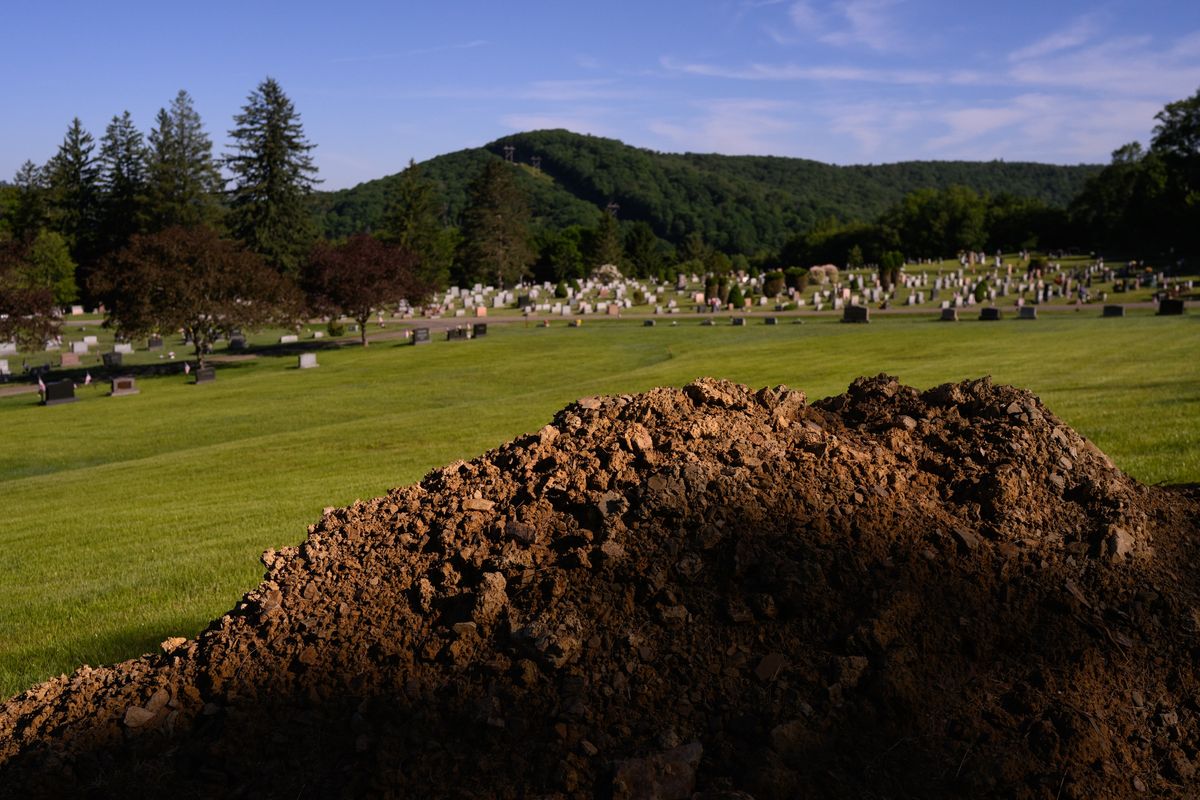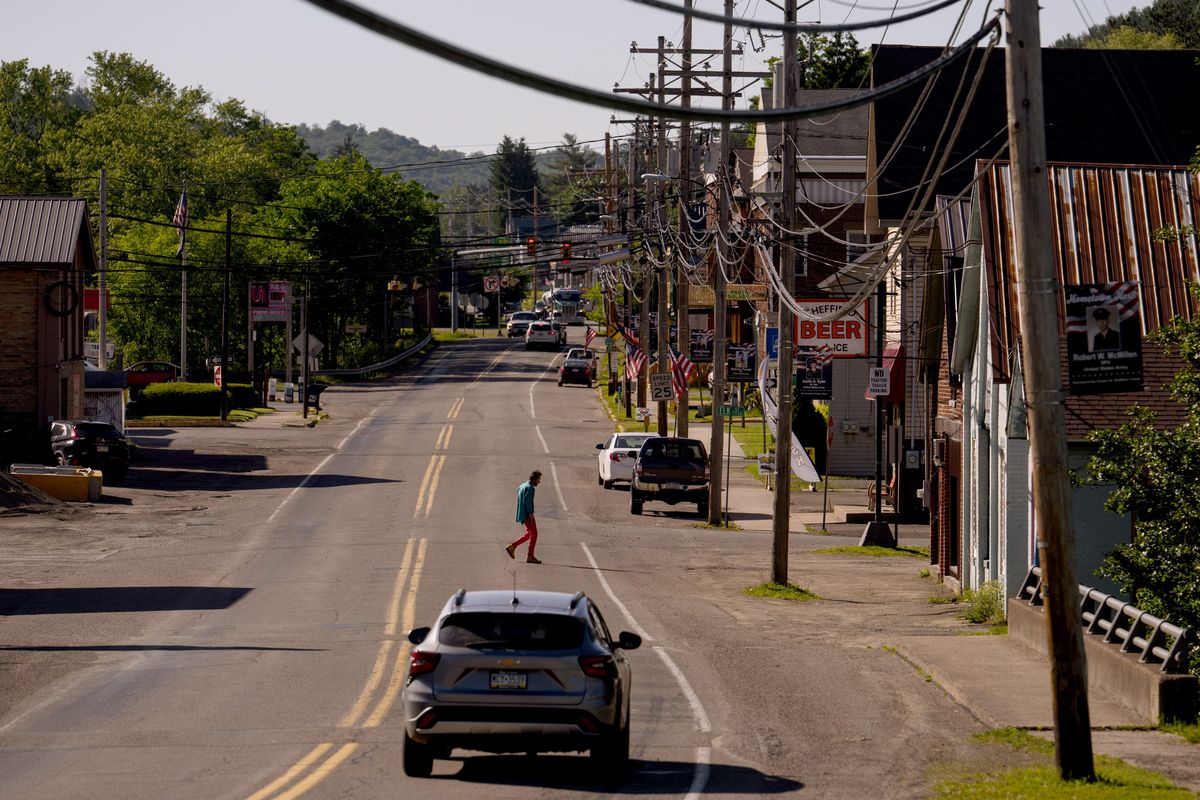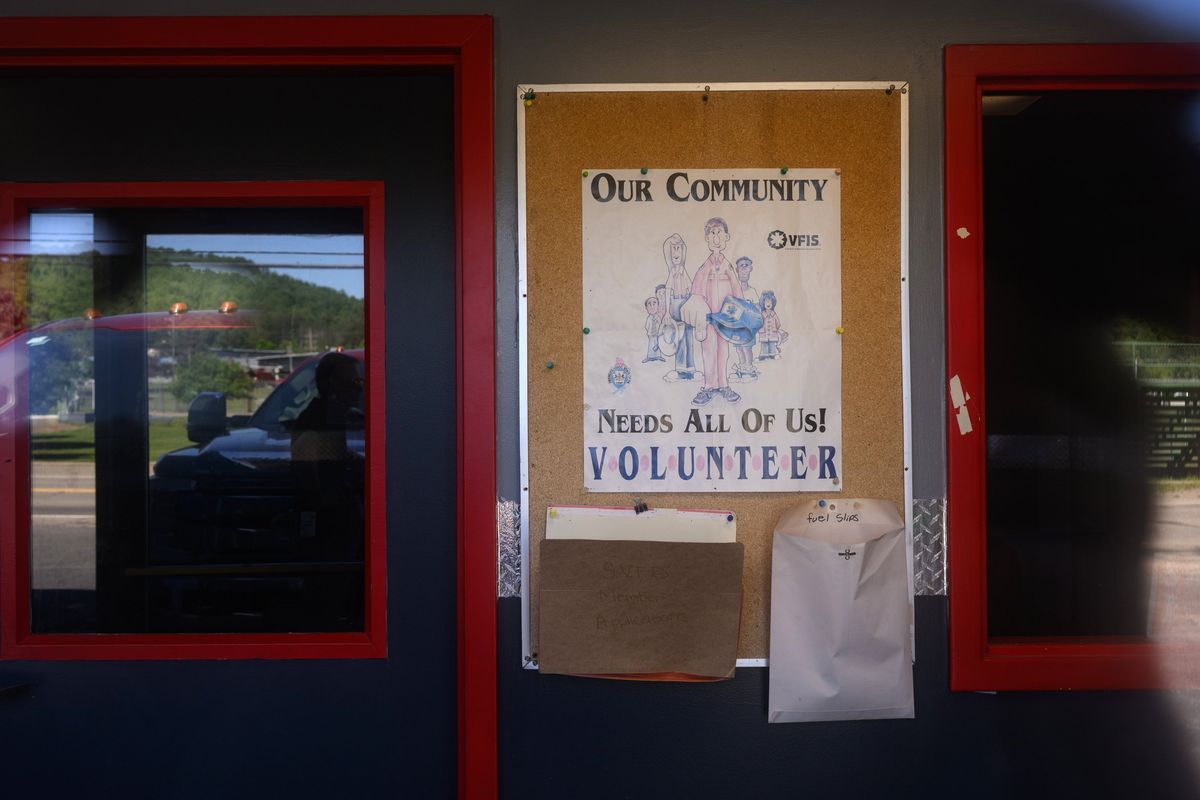‘Too many old people’: Rural Pennsylvania town reckons with population loss
Cars are seen on Main Street in Sheffield, Pa., on May 31. Sheffield is much like many rural Pennsylvania towns, where deaths have outpaced births. MUST CREDIT: Justin Merriman for The Washington Post (Justin Merriman/For The Washington Post)
SHEFFIELD, Pa. - Lee Goldthwaite might have the most stable job in this remote corner of northwestern Pennsylvania.
The caretaker of Sheffield Cemetery is busier than ever directing crews clearing trees to make space for more graves as deaths dramatically outpace births here and in other vast stretches of rural America. Each time he buries a newly deceased resident he wonders how the town that once drew scores of young families will survive.
“We already lost our bank,” Goldthwaite said as he took a break from trimming the grass around headstones. “We lost our liquor store, and we may be about to lose our high school.”
Across rural Pennsylvania, there is a deepening sense of fear about the future as population loss accelerates. The sharp decline has put the state at the forefront of a national discussion on the viability of the small towns that have long been a pillar of American culture.
America’s rural population began contracting about a decade ago, according to statistics drawn from the U.S. Census Bureau.
A whopping 81% of rural counties had more deaths than births between 2019 and 2023, according to an analysis by a University of New Hampshire demographer. Experts who study the phenomena say the shrinking baby boomer population and younger residents having smaller families and moving elsewhere for jobs are fueling the trend.
According to a recent Agriculture Department estimate, the rural population did rebound by 0.25% from 2020 to 2022 as some families decamped from urban areas during the pandemic. But demographers say they are still evaluating whether that trend will continue, and if so, where.
Pennsylvania has been particularly afflicted. Job losses in the manufacturing and energy industries that began in the 1980s prompted many younger families to relocate to Sun Belt states. The relocations helped fuel population surges in places like Texas and Georgia. But here, two-thirds of the state’s 67 counties have experienced a drop in population in recent years.
The Center for Rural Pennsylvania, an agency overseen by the state legislature, estimates that Pennsylvania will lose another 6% of its rural population by 2050. Some counties, including Warren County, where Sheffield is located, will experience double-digit population declines.
State lawmakers and other leaders now consider the population loss a crisis and are drawing up plans to try to reverse the trend. They say neither Pennsylvania nor the nation can afford to lose small towns and the institutions that power them. Not only are they a touchstone of American life, but they are also key to driving certain sectors of the economy, like agriculture.
Already, the demographic shift is affecting where students attend school, how long residents have to wait for an ambulance and whether they can quickly see a doctor. In some cases, local governments themselves are on the verge of collapse as they struggle to fill open jobs and leadership positions.
The decline of small-town life is expected to be a looming topic in the presidential election as both President Biden and former president Donald Trump vie for votes in this critically important battleground state. Trump won many rural voters during his last two presidential campaigns with his populist economic message. Biden, meanwhile, is highlighting his administration’s investments in broadband and major public works projects.
“It’s kind of like building blocks. You pull one block and the wall gets weaker,” said state Rep. Eddie Day Pashinski (D), a lawmaker driving the conversation on solutions to population loss. “You pull another block out, and it collapses and that is kind of where our rural communities are.”
‘Too many old people’
Sheffield hugs the Allegheny National Forest and is about 75 miles southeast of Erie, the nearest big city. In the early 20th century, it was known for having the largest sawmill east of the Mississippi River. Back then, it was a hub for timber and oil exploration.
The town’s decline started decades ago as the lumber mills and tannery shops started closing. But it’s been only in the last decade or so that the full weight of the community’s future challenges began to be felt in intimate ways.
Sheffield’s only ambulance was taken out of service about two years ago, around the same time the community’s only day care closed due to low enrollment. Starting this school year, teens are being bused to a distant high school because there are not enough teachers to staff the local one.
Residents are peeved that the local bank branch and liquor store have closed. The organizers of the town’s beloved Johnny Appleseed Festival recently announced they don’t have enough volunteers or money to continue. And many of Sheffield’s churches no longer have full-time priests or pastors, deepening residents’ sense of malaise.
“I wish I had an idea to say, ‘If you do this,’ this place can be turned around,” said Jack Cashmere, 86, a lifelong Sheffield resident. “But I guess you just have too many old people like myself.”
In Warren County, nearly twice as many people died as were born in recent years, according to the Pennsylvania State Data Center at Pennsylvania State University. Sheffield Township, which includes a broader swath of land outside the town center, had one of the sharpest population declines in Warren County, according to census data. It is now home to 1,805 residents, a 23% decline compared with 20 years ago.
During its heyday, Sheffield was packed with commercial and recreational businesses that gave residents here just about everything they needed to maintain an active, middle-class lifestyle. There was a bowling alley, auto dealerships, doctors offices and pool halls.
High school football games as recently as the 1980s attracted 1,000 spectators, said Dennis Sturdevant, the self-described historian for the township.
Today, downtown Sheffield consists primarily of a small grocery store, a 150-year-old bar, one restaurant, two convenience stores, an antique shop and a small video-gambling room.
After most businesses closed or moved elsewhere, today one of the township’s biggest employers, Sheffield Container, employs just 25 people, said Lonny Connolly, the manager of the industrial packing company. The average salary is $18 an hour.
“I don’t know why the industry is not coming in,” Connolly said. “But I do know that is why people are moving out.”
A small class
The absence of children has Sheffield leaders on edge as they ponder how to keep the town afloat.
In 1980, Sheffield Area Middle-Senior High School had about 600 students. The current enrollment is just 224. The broader Warren County School District - encompassing most of the county - also saw its school enrollment decline by more than half since 1980.
Statewide, the Pennsylvania Department of Education estimates, there will be 60,000 fewer public school students by the 2027-2028 school year.
In a bid to account for the low enrollment and teacher shortages, the district decided to bus students in ninth through 12th grades to Warren, about a 30-minute drive away, each morning so they could learn core subjects such as a math and science. Students return to Sheffield High School in the afternoon for their electives.
But Warren County School District Superintendent Gary Weber said even more drastic steps may be needed, including possibly shuttering Sheffield’s high school altogether.
“There is no sign of growth in the future.” he said.
But to Sheffield residents, the idea that their community might soon be without a high school is alarming. If the school closes, they say, even more families could move out and the town’s problems will grow more entrenched.
Today there are 32 students in Sheffield Township’s graduating class.
Jamie O’Donnell, 33, has a second-grader enrolled in the Sheffield school system and another child entering kindergarten next year. She said having local schools gives Sheffield a “small-town atmosphere,” including the peace of mind that comes with having relatives who are also school bus drivers.
“We have to find a way to make it work,” said O’Donnell, who added that she may have to move her family if the high school closes.
Sturdevant, the town historian, was even more direct about the stakes.
“Once you close the school, your town dies,” Sturdevant, 80, said.
Ann Mitchell, the administrator at Sheffield’s Ruth M. Smith Center, said she doesn’t have much confidence that the numbers will rebound. In 2022, the center closed what Mitchell described as Sheffield Township’s only licensed day care as enrollment sank from an average of 40 children in the 1980s and 1990s to just eight children.
As she scanned an abandoned room where toy trucks, strollers and old blankets now collect dust, Mitchell said the closure is yet another sign that the once vibrant town is fading.
“I think [Sheffield] is slowly dying,” Mitchell said. “But I like to be positive and think there is still some hope.”
‘All gray hair’
Throughout Sheffield and the rest of rural Pennsylvania, the aging population has led to a crisis at one of the most fundamental small-town institutions: the local volunteer fire station.
The nation’s volunteer fire services rely on residents who leave work or home to respond to community emergencies. They have been a mainstay of life in small towns for centuries, putting out fires and transporting residents to the hospital, while also hosting bingo games, fish fries and potluck dinners.
But as the population ages and decreases, fewer people are signing up to serve as volunteers. Jerry Ozog, executive director of the Pennsylvania Fire & Emergency Services Institute, said the state had an estimated 300,000 volunteer firefighters during the 1970s. A state-commissioned study released in 2018 estimated Pennsylvania was down to 38,000 volunteer firefighters, and Ozog believes the number may have decreased further since then.
At many volunteer fire stations in Pennsylvania today, Ozog said, “it’s all gray hair and nobody under the age of 55.”
That has made it harder for fire stations to respond to emergency calls. Growing numbers of departments have also shelved their ambulance service, unable to find enough qualified volunteers who are willing to become a licensed EMT or paramedic. In some pockets of Pennsylvania, the nearest ambulance is now 40 minutes away, Ozog said.
Sheffield Township lost its ambulance in 2022.
Matthew Bell, the chief of the Sheffield Volunteer Fire Department and a township supervisor, said he made the decision to scrap the ambulance because not enough volunteers were responding to emergency calls. The township now contracts with a private ambulance service that must travel about 20 miles to get to Sheffield Township.
“We had four of us running all the ambulance calls and we said, ‘We can’t do this anymore’” Ball, 30, said.
Throughout Sheffield, there is deep concern about emergency response times. Doug Kennedy, associate director of the only funeral home in the township, said he has seen more people die in their homes since the local ambulance service ended.
But Bell said call logs show the wait time for a private ambulance is no longer now than when the township had its own service. And David Basnak, the president of EmergyCare, the private ambulance service that Sheffield contracts with, said it is more routine for paramedics to discontinue lifesaving efforts for heart attack patients at home. That’s because EMTs have more advanced resuscitation equipment on hand than they used to.
“Everything they can do in a hospital for patients, we can do in the house,” he said.
Lonely bar patrons
As the population ages and declines, Sheffield Township has struggled to operate its government and maintain activities that the community can be proud of.
For 17 years, residents looked forward to the annual three-day Johnny Appleseed Festival, when thousands of visitors would cram into town to watch professional lumberjack, horse, tractor, cornhole and pie-baking competitions.
But this spring, event organizers announced they could no longer staff the festival. As residents age, it has become harder to find the youthful volunteers needed to put on such a labor-intensive festival, said Sandy Setili, an event organizer.
“You can’t sustain a festival as big and physically demanding as ours if you don’t have volunteers,” Setili said.
Sheffield suffered another blow this year when several high-ranking township employees quit - including two of three supervisors. The township appointed one person but couldn’t find anyone to fill the second vacancy. It then took the unusual step of putting an ad in the local paper to find someone to keep the local government running.
As the presidential election approaches, many residents in this deeply Republican town say they view Trump as having a better vision for salvaging rural America, even though Biden has steered billions of dollars to initiatives that support rural America.
But at the Lee House, one of two remaining bars in Sheffield Township, many patrons were not optimistic that either Trump or Biden have the answers needed to save the community. The bar, which dates back 150 years and advertises on its front door that smoking is still allowed indoors, now routinely closes at 9 p.m. due to “fewer and fewer people,” said Carla Allen, the bar’s owner.
“I don’t want either of them for president,” said Barb Strike, 54, as she puffed on a Parliament cigarette and sipped a Bud Light. “They don’t care about us because no one in this town is rich enough for them to care.”
‘We are going to stick around’
Jim Decker, chairman of the Warren County Chamber of Business and Industry, said local leaders must figure out a way to reinvent the community. The Center for Rural Pennsylvania report said the county would lose 11% of its population, including 26% of its working-age adult population, by 2050.
Although Warren County lacks easy access to an interstate highway, Decker said the county will try to market its location near state forests and recreational areas such as the Allegheny River to draw in new residents. He even wonders whether climate change could one day force more people to seek out cooler climates such as northwestern Pennsylvania.
But Decker acknowledged the planning for Warren County’s recovery is “a daunting task.”
Kenneth M. Johnson, the demographer at the University of New Hampshire, said the deck remains stacked against most rural communities, except for those within proximity to larger metropolitan regions or those with industries that rely heavily on immigrant labor.
“Barring some outside occurrence, it’s very unusual for counties to recover,” Johnson said.
Goldthwaite, the caretaker of the Sheffield Township cemetery, isn’t yet ready to believe his community will wither.
Even as he laments the loss of 13 people from his church over the past three years, Goldthwaite believes younger families will eventually come. There must be other people, he says, who want to be able to look out their door and see black bears, turkeys and deer, or fish trout out of the Tionesta Creek.
“I don’t care what anyone says about it. I think it’s a great little community,” said Goldthwaite, speaking over the sound of the chain saws clearing more space in the cemetery. “I think we are going to stick around.”











